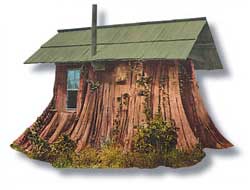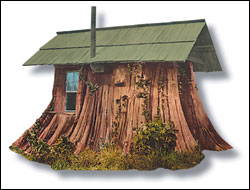I suppose we should be grateful that no one—yet—is suggesting that Seattle Center be spruced up with a skinny skyscraper. But this week, the city’s beloved, bedraggled, and fiscally challenged civic space is being pushed toward the top of the agenda of problems to solve. The City Council is considering how to respond to the SuperSonics’ extortionate demands regarding KeyArena, and a Seattle Center task force was preparing recommendations for Mayor Greg Nickels on how to revitalize a facility that has been described as everything from a “mishmash” to, in the words of King County Executive Ron Sims, a “supersized . . . tourist trap.”
Mossback loves Seattle Center but recognizes that it needs help. It will require public subsidy, revitalization of retail and commercial amenities, some demolition and remodeling, and a financial plan that will preserve it intact: no more selling off Seattle Center property to pay the bills. Like everyone else, I have my personal list of what should stay and what should go. However, before sculpting a specific vision, I’d like to suggest a few principles to guide future development.
The driving one is this: Seattle Center is unique in that it was born from a world’s fair—1962’s Century 21 Exposition. Unlike most fairs, our city fathers saw the advantage of keeping the fair site largely intact. There are very few cities that have hosted world’s fairs where the fair site is so immediately recognizable so many decades after the fact. From the Space Needle to the Pacific Science Center, the International Fountain to KeyArena, the Center House to the monorail—the unique, major landmark structures of the fair are still standing, still in use, and still define the public space. The fair site was designed to be apart from the surrounding city, and this has been wonderfully maintained. The Center is not a city park but rather a cultural zone with parklike qualities. Even at its shabbiest, it is beloved and well used.
In the years to come, there will be massive development outside Seattle Center’s walls as the area is incorporated into an expanding downtown. For that reason, it is vital that the Center remain a space unto itself, with definable boundaries and not violated by through traffic, as it would have been under the now-defunct Green Line monorail plan. Entryways should be improved, but the gated quality is both part of Seattle Center’s heritage and salvation. It must never be confused with the commercial district that surrounds it. Otherwise, it might lose its public identity and mission and become an extension of Allentown.
By remaining a precinct apart, Seattle Center can continue to maintain many of the qualities of a world’s fair. Like a world’s fair, it is a blend of public and commercial interests, featuring high-minded arts (theater, opera, gallery space) and low-brow entertainment (the Fun Forest). A successful world’s fair combines the high and the low into a great show that can stir intellect, fire the imagination, and is fun at the same time. Century 21 was perhaps the most intellectually high-minded world’s fair in history, especially on the subject of science, yet even in earnestness it found room for Gracie Hansen’s burlesque revue and, yes, a dirty puppet show. Remember, too, that this was a fair made famous by Elvis. Crass commercialism has a place, too. Being a tourist trap is OK if that characteristic is leavened by the obvious civic benefit of places where people of all classes can gather, wander, explore, and scream their lungs out. The Center’s strength is that it continues to do that after all these years. There’s no place in the city like it.
A refurbished Center must also avoid the yuppie trap. While neighboring Lower Queen Anne, South Lake Union, and Belltown are burgeoning with high-priced condos, it is essential that the Center remain a place of the people. Tacky as the Fun Forest and Center House are, they have a down-market utility that has kept the Center from being consumed by the upscale preciousness that is devouring the rest of the city. Cheap thrills, cheap food, tacky tchotchkes—these should all have a future at the Center, even if we add outdoor cafes and wine bars. Every world’s fair, after all, is also part Puyallup Fair. To that end, the Center must also remain kid-friendly, at least until the last toddler to leave Seattle has turned out his or her night-light.
One of the greatest additions to Seattle Center, completely in keeping with tradition, is Paul Allen’s Experience Music Project. It is the best world’s fair pavilion Century 21 never had. This wonder cabinet is a shrine to rock and roll, science fiction, and, more recently, major art. It is all housed in a madhouse designed by Frank Gehry and modified by the family of his eccentric billionaire client. It is many things: a gallery, concert venue, restaurant, museum, interactive music zone. Love it or hate it, it is hard not to suggest that visitors spend an afternoon there. It is unique and appeals to a broad range of tastes. The pricey admission aside, it embodies a kind of populism that Seattle Center should continue to embrace: serving up art, science, and kitsch for the whole family.







